Home | Front Page | Blog | Index | New | Contact | Site Map
![]() Japan
Japan
![]() Nagoya
Nagoya
![]() Takayama
Takayama
![]() Gifu
Gifu
![]() Kanazawa
Kanazawa
![]() Kyoto
Kyoto
![]() Shikoku
Shikoku
![]() Henro Pilgrimage
Henro Pilgrimage
Cherry Blossoms
Shrines and Temples
Museums
Bicycling
Kabuki Theater
Food and Lodging
Shibuya
Shinjuku
Yokohama
Narita Town

Travel 2008
Australia
Britain
Paris
Basel
Berlin
Travel 2007
Sydney
Paris
Britain
USA
Canada
Australia 2007-08
Travel 2006
Greece
Turkey
Thailand
Malaysia
Indonesia
Singapore
Travel 2005
Berlin
Paris
Moscow
Russia
Athens
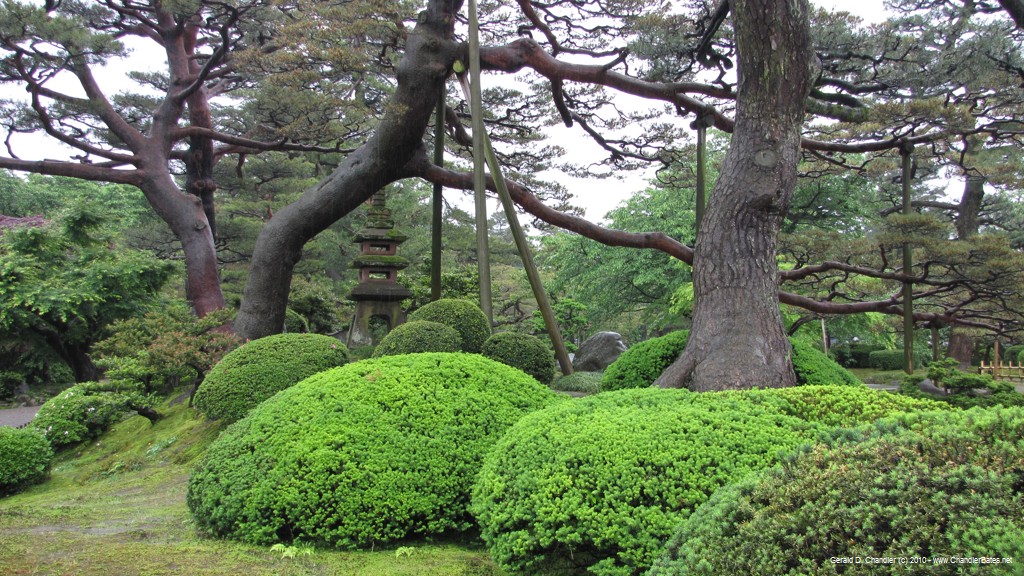
Kenrokuen: Kanazawa Royal Garden |
At last the day arrived when we had to leave the hostel-in-a-temple in Takayama that we had grown quite fond of. We tend always to be fond of places where we stay more than just a night or two. It must be some kind of nesting instinct that kicks in. We had had lovely weather in Takayama, and perhaps it was a portent that as we trundled our bags through the town's quiet early morning streets, we felt a drop or two of rain. In about four hours our bus carried us through Ogimachi and on to Kawazawa. The drops became rain and our good luck streak ended. Our Nohi Bus dropped us in front of the Kawazawa rail station and we had to find our hotel in the rain.
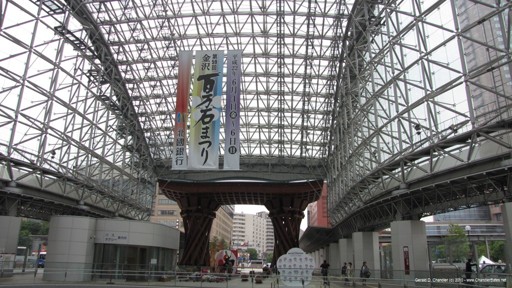
Kanazawa station entrance |
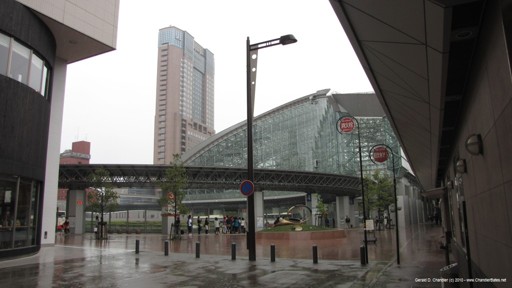
Another view of Kanazawa Station |
Out came the umbrellas and on came the rain protectors and we walked the two blocks with nary a misstep to the hotel Dormy Inn. This turned out to be a pleasant discovery and made us less shy of big hotels. Normally we take small hotels, usually hostels, with cooking facilities and a chance to easily meet other travelers. But the Dormy Inn was a businessman's hotel, with all spacious, modern-style rooms, and ensuite shower room and toilet. The greatest pleasure for Jan came from the top floor spa bath, which we both quite enjoyed each night, but she adored. It made the ensuite shower superfluous because the spa bath had showers. The baths occupied a good part of the top two floors (of about 15); the men's was on top and one could sit out and cool off from the hot water and look at the stars (if it hadn't always been raining). The baths (really large hot tubs) came in three flavors: an indoor hot bath, an outdoor hot bath, and a cold bath: once clean and rinsed, you could hop happily from one to the other to your heart's content.
Another advantage of the Dormy Inn was its closeness to the station. On the day of our arrival we stashed our bags in the Dormy Inn and then returned to the train station to eat in a place we'd already seen; it became our favorite place in Kanazawa. It was called the German Bakery, but it also sold hot drinks and had tables for customers to eat the wonderful stuff they sold. Japanese food is great, but one can get homesick for familiar stuff, especially bakery rolls the way we liked them. Just in front of the station was the start/stop point for the low-fare tourist bus that looped through all of the tourist sites (17 stops). We had a great lunch and then jumped onto the bus.
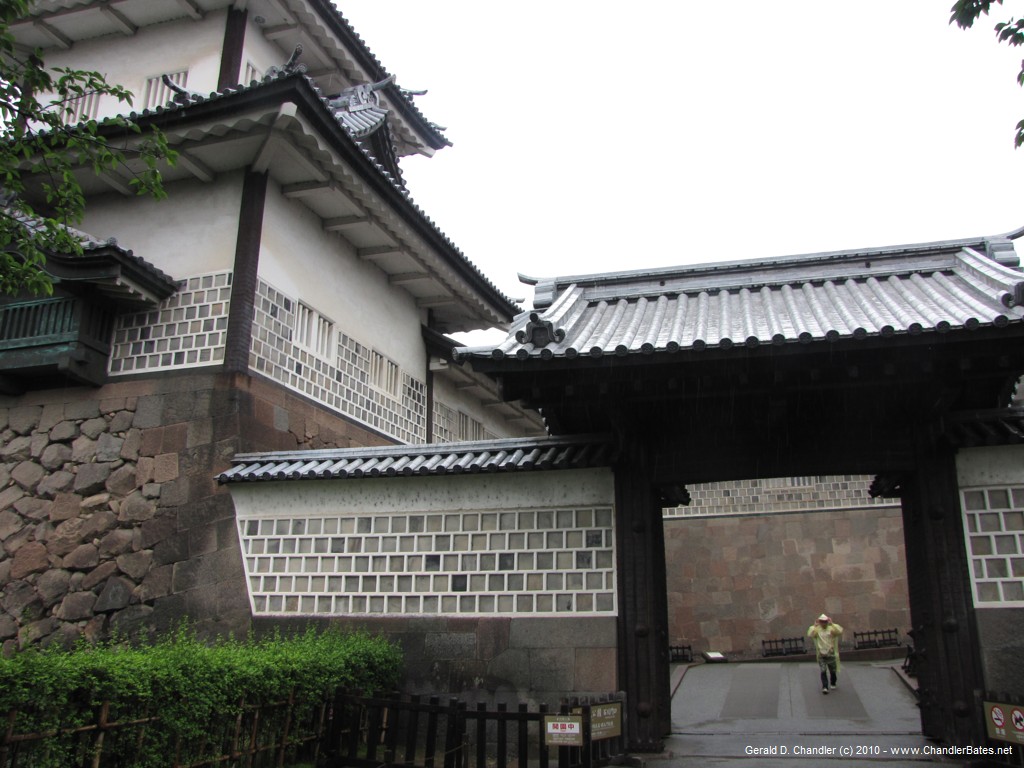
Kanazawa Castle Gate |

Kanazawa Castle |
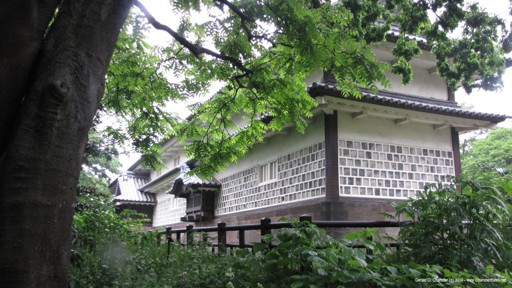
Kanazawa Castle |
The main reason most tourists come to this rather plain medium-sized town is to visit the famous Kenrokuen garden, which is reputed to be rank as number three in all of Japan. We decided to put it off to the next day in the hope that it would be sunny and dry and that we could have lots of time in the garden. Instead we visited its next door neighbor, the Kanazawa Castle. Almost every Japanese city of a respectable size has a castle, built usually by the local nobleman when he was trying to protect himself from neighboring preditors, and, if lucky, eat them and their lunch.
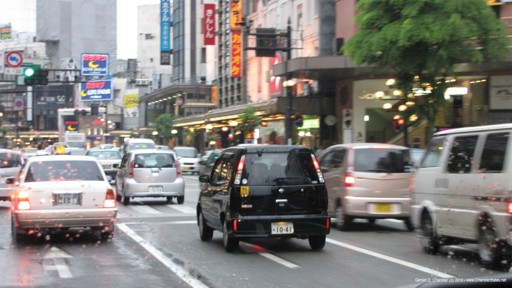
Modern Kanazawa |
Kanazawa was no exception (in fact, Kenrokuen was the lord's pleasure grounds). In spite of the damp weather, we spent a pleasant couple of hours wandering through the extensive grounds and gradually climbing up to the castle level and getting good views of the city. One particularly interesting outdoor exhibit was a life-size, cut-away wall that explained construction techniques. Having seen all of the outsides of the buildings and nothing of the museums they contain we set off to walk the few kilometers back to the Dormy Inn, and thereby got a feel for modern Kanazawa, which, no surprise, is modern.
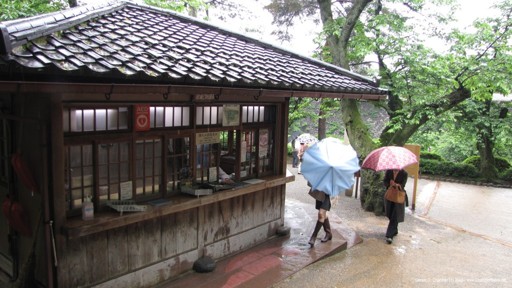
Kenrokuen Garden Entrance |

Kenrokuen Tourist Umbrellas |

Kenrokuen Garden |
On the morning of our first full day, we visited the famous garden. Famous garden? Could hordes of mostly Japanese tourists be far behind? No, so Kenrokuen is busy all the time, even in the rain. And in the rain is how we saw it. It was the rainy season, and it fell in buckets. And rain became the real main theme of our stay in Kanazawa. We began to understand the local slogan: "even if you forget your lunchbox, don't forget your umbrella". Gerry still has the plastic raincoat he bought.
The "garden" was in fact a fairly large park, laid out on Japanese principles, with sections for different kinds of created views. It had quite a long narrow stream running through it that hosted the iris gardens, just beginning to bloom. There were alleys lined with cherry blossoms for the O hanami fans, and so on and so forth. Except for the taking of photos, the rain added a certain charm to these artificial landscapes. It was indeed very nice, although we are not sure it is worth a long trip to see it and only it. But perhaps that is more a sign of how much travel we have done and how many wonderful things we have seen, than a reliable estimate of the worth of this garden. In spite of very heavy rain during almost our entire visit, we covered all parts of it in about an hour and a half. We think most people get through it in half an hour.
It was about lunch time when we left the garden and set out to find the Teramachi temples on the south-east side of town. We walked, and we expected to find dozen of places to eat along the way. Not a one, not even a purveyor of bento boxes. We were deperate when we passed what was clearly a family run neighborhood eatery. It was almost as good as the Hashi Zen restaurant in Takayama. It was cheaper and plainer but the food was good. And we were out of the rain.
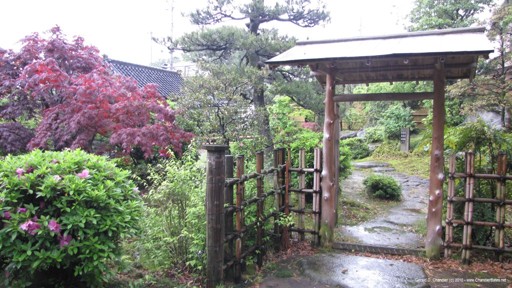
Teramachi Shoseien garden |
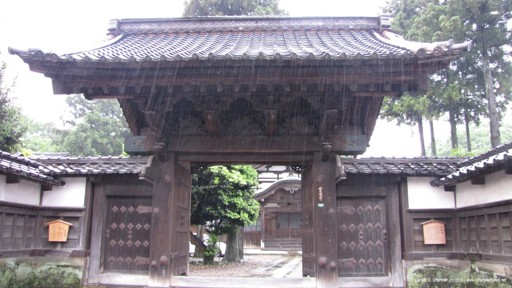
A Termachi temple gate |
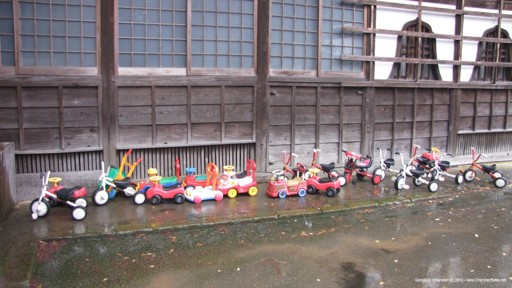
Toys in Teramachi temple |
After lunch we went on to the temples. There are dozens and dozens, and each has a charm of a kind. But none is magnificent and overwhelming as in Kyoto (and even Nagoya). Many of the temples were either temple in name only or dual use. One appeared to be a used car lot; another was a nursery school with toys scattered about. And in the rain we couldn't even be very happy moseying about. Duty done, it was back to the Dormy and a hot tub. (But an afterthought: recalling Lonely Planet Japan and reading Wikitravel/Kanazawa we are quite willing to believe the rain caused us to miss the most important temples.)

Omi-cho market |
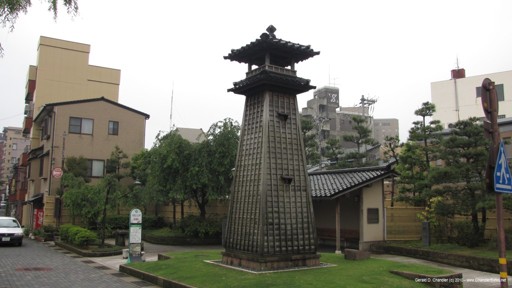
Asanogawa fire watch tower |

Higashi geisha street |
Our second full day started with a bus ride to the Omi-cho market and then a walk further east past several small temples to the Higashi-chaya area. Gerry always loves markets: they are a photographers dream, with plenty of riotous color. This one was no exception as regards the fruits and vegetables; in addition there were an exceptional number of colorful fish. As we crossed the Asano river into the Higashi-chaya district we saw a strange pyramidal wooden tower. As there was a police koban almost adjacent we decided to try our luck and see if a policeman would both be able to speak English and know what the tower was. Success on the first ground: one of the three men at the koban could speak English but none knew what it was, although obviously they saw it everyday. Not to worry: they got on the phone and after a few calls reported back to us that it was an ancient fire warden's tower, now an outdoor museum piece. We'd already seen several and, knowing what they were, noticed many more in the future.
From the koban we went on a few blocks to the restored geisha district. Although it was locally very famous and revered we were underwehlemed. After you've seen a champion baseball or football team the farm teams (unless they are your home town) aren't too impressive. Jan did enjoy the visit to the former geisha house, mostly because she liked the inner courtyard garden so much. Only a postage stamp size garden, it managed to pack such a lot into such a small space.
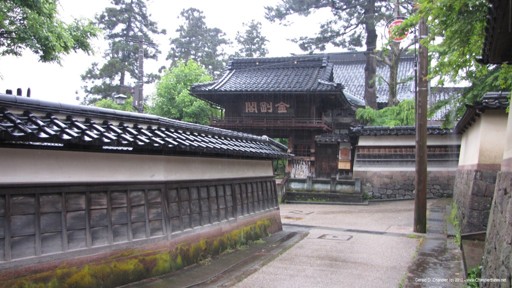
Utatsuyama temple |
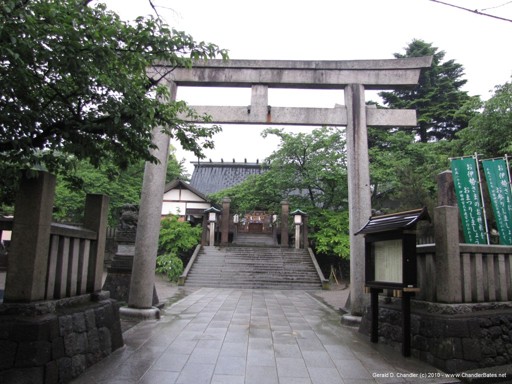
Utatsuyama temple |
Up the hill from there was the Utatsuyama temples district. Jan was willing to be dragged to a few of them while it was still relatively flat but as the climb really began she left Gerry to go on by himself while she waited in the shelter of a convenience store. For Gerry the rain made the area all the more romantic as it was nearly deserted and he felt as if he was rediscovering something lost for ages.
Besides the famous garden another of our reasons for going to Kanazawa was to see a Japanese city that was off the tourist track. And still another was for a look at the Sea of Japan, within walking distance (just over six kilometers) of Kanazawa Station. In fact, our original intention was to go to the coast and, if we found a room that we liked, to stay there several days. But it wasn't beach weather of any sort and there being no notable temples or other tourist bait on the coast, at the end of two and a half days we were ready to leave for Kyoto.

MK Bus Departure |
From the moment of our arrival we wondered how we would get to Kyoto, our next stop. Train or Bus? A very helpful woman in the tourist office provided us with schedules and helped us decide. She told us about MK Tour bus, a discount bus line like Willer Express, which we took from Tokyo. MK Bus saved money by not having any offices &mdash one bought tickets through ATM machines. When we went off to buy our tickets we found that our foreign credit cards would not work; back we went to the tourist office for advice as to what to do next and our super helpful lady went to the ATM and bought the tickets with her card and then we reimbursed her. The bus itself was super clean, super comfortable, and got us to Kyoto on time.